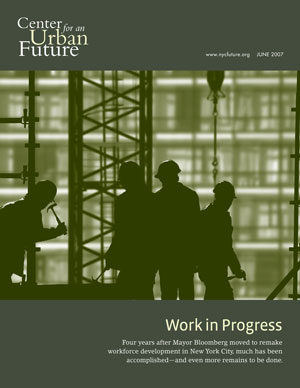Good afternoon. I’m David Fischer, project director at the Center for an Urban Future. The Center is an independent, non-partisan think tank that conducts research on issues of economic development, workforce development and other policy matters of importance to New York City.
I’m pleased to be testifying before you today, a little more than a year after Mayor Bloomberg reorganized the city’s workforce development efforts to task the Department of Small Business Services with primary responsibility for policymaking and implementation. The Center was strongly in favor of the reorganization then, and the track record DSBS has compiled to date has confirmed the wisdom of this move. The Department has made big strides to reverse the preceding several years of policy drift and lost opportunities. These have included the opening of new one-stop centers to provide services to both jobseekers and employers; gaining state certification for the city’s one-stop system and thus making New York City newly eligible for a variety of state benefits; successfully pursuing high-profile job development projects including Manhattan’s Columbus Circle--a project in which Councilmember Gale Brewer provided initial impetus and played a crucial convening role--Brooklyn’s Atlantic Terminal and Steiner Studios, among others; strengthening the city’s Workforce Investment Board with first-rate staff, led by executive director Marilyn Shea; opening Business Solution Centers within the one-stops; and moving towards a comprehensive strategic approach for city workforce policy responsive to the local labor market and focused on development in key sectors such as healthcare and hospitality.
But as Commissioner Robert Walsh and others have alluded to earlier today, there is still a great deal to do. And while DSBS has acted boldly to address some of the most immediate problems, flaws in the structure and organization of workforce resources and program development still threaten the overall effort. I’d like to briefly speak about two of these issues.
First and perhaps most fundamentally, DSBS and the Workforce Investment Board have only started to link a number of important programs to the one-stop career centers. Merging and uniting the myriad partner agencies and funding streams is an extremely difficult task, but it must be done; otherwise it will be a one-stop in name only. The city must do more to present jobseeker participants with a full range of service options. Right now, jobseekers entering a one-stop may be able to access basic workforce services of resume writing and job placement, and could get a voucher worth up to $2,500 to purchase job training services. It’s much less likely that they’d be able to access educational loan programs like Pell Grants or training programs administered by agencies like the New York City Housing Authority.
This isn’t just an academic point. Chairman [James] Sanders and others have correctly stated that federal allocations under WIA are already too meager, and funding levels are likely to remain flat or decline further over the next several years. The only way to really get value out of those resources is to leverage them with other funding streams.
The Center for an Urban Future released a report late last year titled “Seeking a Workforce System” that maps out some 30 different funding sources available for workforce services. I have brought extra copies of this 4-page fold out of all the programs. We have distributed this widely and believe it is a good starting point for assessing the broad spectrum of programs that should all be accessible to jobseekers. To better augment available resources, the agency must work more closely with mandated partners that control some of those funding streams, such as the SUNY system and the Department of Education. Partnerships such as the one DSBS has explored with the city Department of Corrections, which the Commissioner alluded to earlier, must become the rule, rather than the exception.
We know DSBS is capable of this kind of leveraging effort, based on its approach to serving business customers through the newly opened Business Solution Centers. The agency must now apply the same traits of flexibility, good partnership instincts, willingness to combine functions for greater efficiency and comprehensive attention to the needs of their business customers to its efforts on the jobseeker side.
The other issue has to do with services for older youth, and the imperfect relationship between DSBS and the Department of Youth and Community Development. Both agencies could do more to assist this key segment of our future workforce that is falling through the cracks.
New York City is home to approximately one million residents between the ages of 16 and 24—ten percent of the city’s population. It’s now estimated that more than one in five of this group are both out of school and not in the workforce. And the problem is getting worse: each year, another 50,000 or so older teens drop out of school and join this idle group.
Officially, both DSBS and DYCD have authority to provide services to this group, and the city Department of Education is also involved in some programs to serve them. But the vast majority of these young New Yorkers are not receiving any services toward getting them back in school or connecting them with jobs. The one-stop centers do not presently have DYCD staff on-site, and the operators do not appear to make any distinction between serving a 22 year-old who has never held a steady job and a 40 year-old laid off after many years of work. Obviously these two types of clients have very different needs.
Communication and coordination are the key issues here. The city lost an important connection between youth and adult workforce issues with the elimination of the Department of Employment. The Center for an Urban Future fully supported the reorganization of workforce responsibilities and particularly the transfer of adult funds to DSBS, but the resultant split in youth and adult funding between two different agencies created a new challenge to the continuity of the programs. This means that communication between DSBS and DYCD should be intensive and frequent. To ensure this level of communication and planning occurs we recommend that the City Council and the mayor’s office facilitate combined efforts and request joint planning documents from both agencies. Additionally we strongly recommend that the WIB be sure to address older youth in its upcoming strategic planning document.
It will not be easy to address the two challenges I have described here. Much of this work—sharing resources, rationalizing functions and figuring out the specifics of operational partnerships—should have been done years ago, before the one-stop centers opened. Through a combination of official neglect and the successive crises of economic slump and terrorist attack, it was not addressed then, and now DSBS has a great deal of work to do and a lot of ground to make up. But if the city is genuinely committed to getting the most out of its workforce investments, it must take on these tasks.
Thank you for this opportunity to testify.






